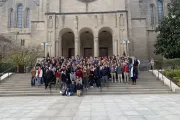“Whenever the day comes to take it away, they’re taking it away whether her house is done or not,” he said.
“It’s kind of selfish why I come down here. It’s just the feeling I get to be able to be part of helping somebody like that. It’s selfish.”
This was Aly Fournier’s fourth trip to the Mississippi Gulf Coast.
“When I came the first time, it was just a really touching experience for me,” said Fournier, who is a sophomore political science major at Emory University in Atlanta.
“Even though the labor I did meant a lot to people, it was like just my presence here helped to instill hope in this badly damaged community. I really like the people and I like the community feeling I get when I come down here to help, so I’ve been coming back. I come down with my mom, my sister and, normally, one of my cousins. It’s a good bonding time for us too.”
This was Joseph Catanzaro’s first volunteer trip to the Mississippi Gulf Coast. The St. Mary parishioner spent the week working at a low income rental property for people who lost their homes during Katrina.
Catanzaro, who is a turf manager for Boston College University athletics, said that, prior to coming to Mississippi with his 16 year-old daughter Kelsey, who had previously made the trip; he didn’t really have any idea of what he was getting into.
“I’ve only seen the good,” he said. “We have sixteen vans with six kids in each van, so there are groups that have seen some worse areas,” Catanzaro said.
“My daughter worked at a soup kitchen and she enjoys doing it, but she was devastated by how many people actually walk out of the woods that have no homes and she said they served about 525 people in one day. So, when I hear about that, there’s still a lot of work to be done here.”
Gene Muller, also a parishioner at St. Mary in Holliston, has made three trips to Camp Hope and said each trip changed his life. Last year, he was in charge of a group of kids that built a wheelchair ramp for Thelma Abrams of Gulfport and, before the group left for Massachusetts, they promised Abrams they would be back to visit her. This year, they made good on that promise.
“Seeing that she was benefiting from the work that my kids did really changed my life some more,” he said. “It makes it all worthwhile. She couldn’t wait to hug me and tell me how the experience has prompted her to go back to church on Sundays. I never thought that, in my life, somebody would tell me that something I did would make them start going back to church.”
(Story continues below)
Subscribe to our daily newsletter
John Armstrong, a local volunteer who has been helping out at Project Hope and Compassion for three years, agrees with Catanzaro that there is still a lot of work to be done.
“A lot of people that are in need now fell between the cracks during all of the major stuff,” said Armstrong, who, has worked with Habitat for Humanity for about 15 years.
“With all the focus on gutting houses and rebuilding, there are still a lot of people who have little things left to finish up to make their place livable and those that weren’t directly affected by the hurricane who would have gotten help except for all of this Katrina relief.”
“Some of the volunteers that are coming now are doing some of those things and they’re having every bit of a rewarding experience as they did when they were tearing out sheetrock and things like that four years ago.
Armstrong, who is a Methodist, said Project Hope and Compassion has been an invaluable asset to the Mississippi Gulf Coast post-Katrina.
“I tell (Karen Parker) every time I come out here that this is about the only thing close to its size that is still working here,” he said. “The Methodists still have two camps and they’re going to work till next April. Most of the others have gone out of business and folded up, so Project Hope is a real beacon.”


